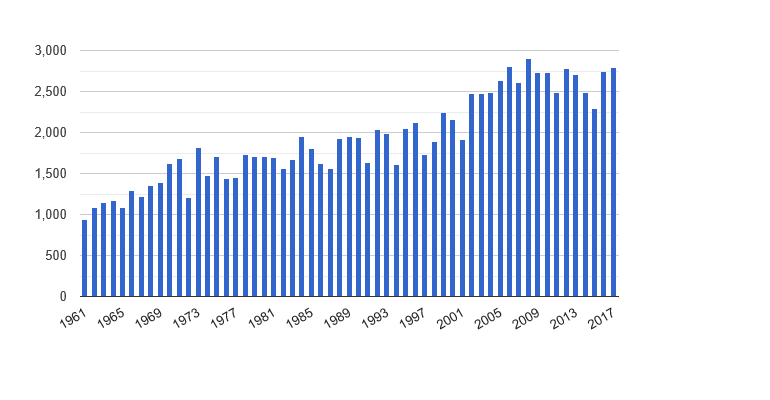Historically, climate change, just like the seasons, follows natural cycles—solar cycles, shifts in ocean currents, and orbital cycles, for example.
Alarming climate stories also come in fairly predictable (news) cycles. During wildfire and hurricane seasons, when natural weather conditions have historically produced hurricanes and wildfires with regularity, compromised scientific journals and the press will run myriad stories linking any ongoing wildfires and hurricanes to human-caused climate change. This happens despite a lack of evidence that hurricanes or wildfires have become more frequent or more severe during the recent period of modest warming than they have been historically.
This sentiment also rings true for the farming industry. Global crop production has boomed in recent decades, with new records set for yield and production year over year in spite of the recent warming, according to United Nations Food and Agriculture Organization (FAO) records. However, what’s true at the macro level is not always true at the micro level. Each year, some area or another will experience record late-season cold spells, floods, or drought, resulting in failed harvests. This is how life has been since humans stopped focusing on hunting and gathering and settled down to farming. Yet when crops fail, one can expect a flurry of journal articles and overheated news stories linking isolated instances of crop failures to climate change. Not only that, but these articles claim crop failures are the harbinger of a disastrous global food future, absent political actions ending the use of fossil fuels.
In between these seasonal weather events, climate alarmists don’t sleep. Instead, they try to tie climate change to any ongoing political and social upheaval anywhere it is occurring. A pandemic breaks out? Climate change caused it. War or political revolutions break out? Climate change caused it.
Another periodic climate crisis de jour is the “climate refugee crisis.” According to climate alarmists, when refugees fled Syria during its civil war, climate change caused it. Now, as a flood of illegal immigrants breaches the U.S. southern border daily, a Google News search displays dozens of news stories in local papers and national publications that claim climate change is creating the problem. The articles say the Biden administration should recognize “climate refugees” as an official class of persons deserving asylum on humanitarian grounds.
Climate conditions did not change between the Trump and Biden presidencies, so it is clear the present flow of illegal immigrants into the United States is not a result of climate change. Instead, President Joe Biden’s shift to a more welcoming immigration policy than that enforced by President Donald Trump has made entering the country more promising. But you wouldn’t know this from reading mainstream media stories discussing the current crisis at the border.
For example, the International Policy Digest (IPD) and The Hill published articles titled “It’s Time to Recognize Climate Refugees” and “How to manage migration intensified by climate change,” respectively. The IPD article falsely stated “refugees are … fleeing climate change.”
“In the face of warmer temperatures, reduced precipitation, and blighted crops—struggling farmers from Guatemala and El Salvador are giving up and fleeing to the U.S. border,” the IPD article states. “Climate change will submerge American communities like Isle de Jean Charles, Louisiana, and entire countries like the Maldives.”
The Hill also cited refugees from El Salvador and Guatemala as proof of climate change causing migration. For good measure, it then threw Honduran refugees into the mix, blaming 2020’s hurricane strikes in Honduras on human greenhouse gas emissions.
Yet looking at each of these claims in detail, one can find no significant link between the past century’s modest warming and forced emigration from any of these countries. Instead, research shows many parts of the American coast and most small-island nations, including the Maldives, have seen their respective land masses, populations, and property values increase in recent years, rather than seeing them sink under rising seas and emigration.
Research published in 2018 by GIScience & Remote Sensing found 15 of the 28 uninhabited islands on Tuvalu’s Funafuti Atoll had their shorelines increase in recent years. Also, the population on Fongafale, Tuvalu’s largest island, has increased by 33 percent. Tuvalu’s government has felt confident enough in its long-term future to erect brand-new government buildings and associated infrastructure.
The U.N. Intergovernmental Panel on Climate Change (IPCC) 2018 “Interim Report” observes there is “only low confidence for the attribution of any detectable changes in tropical cyclone activity to anthropogenic influences.” History shows it is not uncommon for hurricanes and tropical storms to strike Honduras, which is “brushed or hit” by hurricanes every four years on average, although some decades have been busier than others. For example, the 1890s, the 1930s, the 1960s, and the 1970s—all of which were cooler time periods than today—saw multiple hurricanes striking Honduras. One of the worst hurricanes ever to strike Honduras was in 1934, nearly 90 years of climate change ago.
Data from the FAO, shown in the two graphics below, demonstrate that crop yields and production for most major crops in El Salvador and Guatemala have boomed in recent years regardless of drought cycles.


Shamefully, IPD even trotted out the long-refuted lie that the Syrian refugee crisis, beginning in 2011, was caused by drought and failing crops. In truth, mass migration from Syria stemmed from a civil war as people sought to overthrow the Asaad regime during the Arab Spring democracy uprisings and the efforts by Al-Qaeda to establish a Muslim caliphate. Climate change had nothing to do with Syria’s refugee crisis.
Syria is in an arid, desert region where, for thousands of years, droughts have been the norm, not the exception. In fact, the entire region experienced the same drought as Syria, yet neither war nor mass emigration broke out in Iran, Israel, Jordan, or Saudi Arabia.
The battle for freedom, not food, was responsible for the Arab Spring revolutions in Syria and other countries around the same time. When the disingenuous Syrian-climate-refugee narrative first reared its ugly head, FAO data showed Syrian crop production had increased by approximately 50 percent since 1995, as Heartland Institute President James Taylor pointed out. In addition, Syria’s 2011 Arab Spring uprising occurred in a year in which the nation’s farmers produced the eighth-highest crop yields in the country’s history.
The constant attempt to link illegal immigration to climate change is part and parcel of what one author referred to as “the endless, fruitless search for climate refugees.”
Millions of people flee their homelands each year. The causes are what they have always been: war, political persecution, and poverty, not climate change. Refugees now, as they always have, are leaving their countries in pursuit of a better life for themselves and their children. Climate refugees, if they exist at all, are few and far between, and they provide no justification for authoritarian policies to fight climate change.
— H. Sterling Burnett
SOURCES: International Policy Digest; The Hill; Climate at a Glance: Climate Refugees; Climate Realism; Food and Agriculture Organization; American Thinker; The Heartland Institute
IN THIS ISSUE …
HUNDRED-YEAR FLOODS BECOMING LESS FREQUENT … FINLAND FEARS 2020 SNOW WON’T MELT THIS SUMMER
HUNDRED-YEAR FLOODS BECOMING LESS FREQUENT
New research published in the journal Geophysical Research Letters (GRL) finds the frequency of so-called “hundred-year floods” has decreased over the past fifty years, to the extent that such events have been occurring only once every 358 years on average since 1970.
An international research team lead by Oxford University’s Louise Slater, Ph.D., finds reports of dramatic increases in flood magnitudes, frequencies, and probabilities of occurring during the recent period of modest warming are based on flawed methodologies for calculating and tracking flood events.
Using a “nonstationary approach” to account for changes in stream course, development, and topography over time, the GRL study reports, “Empirically, we find the 20‐/50‐year floods have mostly increased in temperate climate zones, but decreased in arid, tropical, polar, and cold zones. In contrast, 100‐year floods have mostly decreased in arid/temperate zones and exhibit mixed trends in cold zones….”
Overall, the research finds there has been a clear decrease in both the frequency and probability of floods on the time scales of 20, 50, and 100 years. For instance, for any given location in the 1970s—a time when the Earth was cooling modestly—there was a 45 percent probability a 50-year flood would occur, whereas at present there is only an 18 percent chance a 50-year flood will occur.
This research bolsters the findings of the U.N. Intergovernmental Panel on Climate Change, which reported having “low confidence” in any climate change impact regarding the frequency or severity of floods worldwide. The IPCC reports it even has “low confidence” any “sign” of a change can be measured. This means it is equally likely that climate change is making floods less frequent and less severe as that it is making them worse.
SOURCES: Geophysical Research Letters; Climate Change Dispatch
FINLAND FEARS 2020 SNOW WON’T MELT THIS SUMMER
In 2000, The Independent ran an article titled “Snowfalls are now just a thing of the past,” quoting David Viner, Ph.D., then a senior research scientist with the infamous Climate Research Unit at the University of East Anglia, saying “within a few years winter snowfall will become ‘a very rare and exciting event. Children just aren’t going to know what snow is.” The Independent has since removed the article.
To be fair, as catalogued on the Climatism blog in 2019, Viner and The Independent weren’t the only scholars and mainstream media shills for climate alarmism to claim human-caused climate change would soon make snow a thing of the past. The New York Times, for example, ran an article titled “The End of Snow?” in 2014.
Viner’s and others’ repeated warnings that snow is soon to be a thing of the past seem foolish in light of the mounting (as in mounting snow drifts) snowy winters that have been fairly common in the United States and globally over the past 20 years. Five of the six snowiest winters ever recorded have occurred since 2000, and 2020 can be added to the list.
Data show the total measured amount of winter snowfall has not changed much since 1972.
The European Institute for Climate and Energy is reporting so much snow fell in Helsinki, Finland in the 2020/2021 winter season that the manager of the dump where they pile up snow cleared from Helsinki’s streets says it is unlikely the mounds of snow will melt before the next winter comes. In other areas of Finland, EIKE reports:
In Uusimaa, for example, the amount of snow in January was 1.7 times higher than last year, according to Foreca.
Helsingin Sanomat [a Finnish Newspaper] wrote … the piles of snow at the rubbish dump in Herttoniemi, east of Helsinki, reached a height of almost 20 meters. In Maununneva, a north-western district, trucks have dumped around 16,000 loads of snow on the dump, according to Tero Koppinen, production manager at Helsinki City Construction Services (Stara).
So much for so-called consensus scientists’ supposedly authoritative knowledge of the consequences of climate change. It has been 32 years since NASA’s James Hansen famously stated, in a carefully staged Senate hearing, humans were definitely causing dangerous global warming. If climate scientists haven’t been able to accurately forecast the impact of a modestly warmer world on snowfall in the decades since then, why should anyone trust their projections 50 and 100 years into the future?
SOURCES: European Institute for Climate and Energy; WUWT; Climatism; WUWT
The Climate Change Weekly Newsletter has been moved to HeartlandDailyNews.com. Please check there for future updates!





